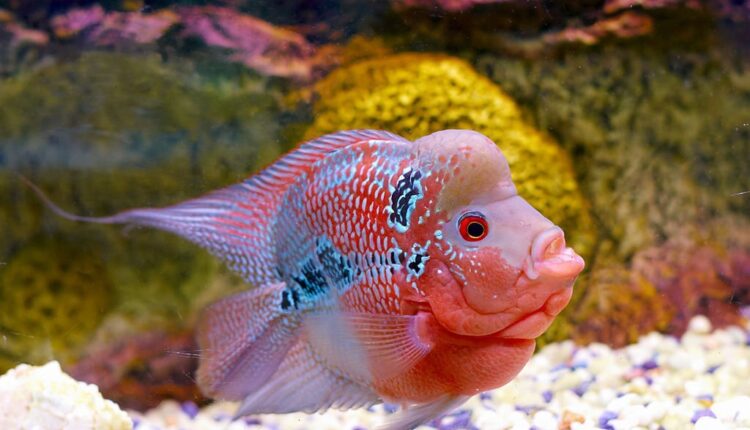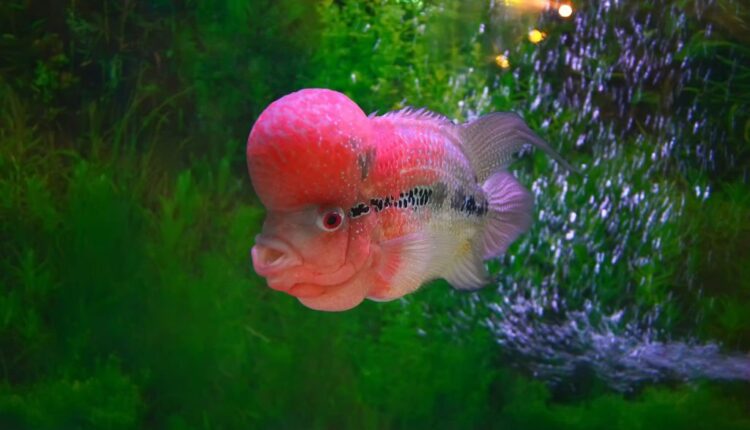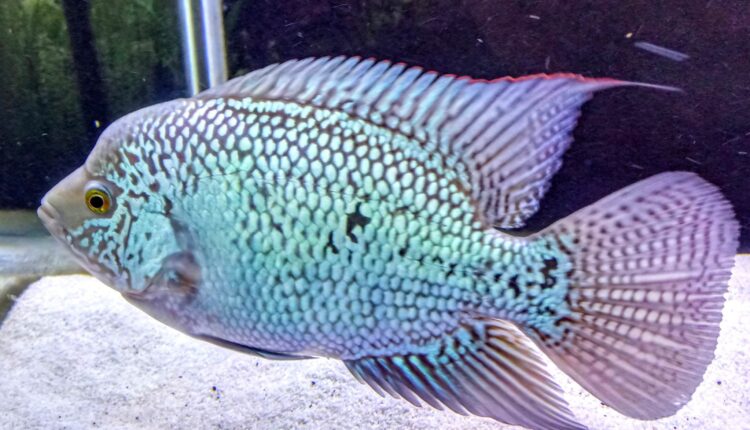Flowerhorn Cichlid: Care, Breeding, Diet & Behavior

Flowerhorn Cichlid is a freshwater fish and has gained popularity due to its distinct looks. It originates from the Asian countries like Thailand, Taiwan by selective breeding. Adding them into your aquarium provides definitely gives an awesome look to your aquarium. In this guide I discuss about Flowerhorn Cichlid Tankmates, Tank Requirements, its food, common diseases of Flowerhorn and how to prevent them. Also, I will discuss about the Flowerhorn breeding as well.
Flowerhorn breeding started in the year 1993 and is a hybrid of red devil cichlids, blood parrot cichlid and trimac cichlids.
This selective breeding continued till 1998 by importing the Seven-colors Blue Fiery Mouth fish from Central America along with Jin Gang Blood Parrot fish from Taiwan to create the first generation Flowerhorn fish called Hua Luo han Flowerhorn hybrids.
In the subsequent years there were four varieties of Flowerhorn like golden flowerhorns, faders, regular Flowerhorn and pearl-scale flowerhorns.
Between the year 2000 and 2001, a new variety called Kamfa Flowerhorn appeared. Again, Kamfa was a hybrid of a regular flowerhorn and species of the genus Vieja or parrot cichlid. The Kamfa Flowerhorn has an amazing characteristic such as wrapped tails, small mouth and larger head bump and is even better looking than the regular flowerhorns.
Below is the Flowerhorn Variety classification which contains different varieties (strains) from different countries and breeders. The popular ones are the Golden Monkey, King Kamfa, Zhen Zhu, Thai silk and Red Dragon Flowerhorn.
Flowerhorn Cichlid Overview
| Family: | Cichlidae |
| Temperament: | Moderate to aggressive |
| Size: | Up to 16 inches |
| Minimum Tank Size: | 75 Gallons |
| Diet: | Omnivore |
| Care: | Intermediate |
| pH: | 6.5 – 7.8 |
| Alkalinity Levels: | 9 – 20 dGH |
| Temperature: | 79°F – 86°F |
Appearance
You cannot go wrong in identifying the flowerhorn fish due to its distinct bump in the head and this is one of the reasons for the high demand for this fish. The rest of the body is long and has symmetrical appearance.
Another thing to notice here are the planted eyes and these look like as though the fish is trying to observe you more. The male Flowerhorn Cichlid has a protuberant lip and hence their face looks expressive. This is the reason for their popularity.
Flowerhorn Cichlid can grow between 12 to 16 inches in length. Males are larger than the females. Among all the Flowerhorn breeds, the Kamfa breed is the longest one.
Hence if you are planning to have flowerhorn, ensure that the size of the fish tank is big.
Behavior
Flowerhorns are very aggressive and you need to judge carefully which fish you are going to put along with them. They are very territorial and make sure you give them enough space.
Sometimes they can be very friendly to the owners and playful. They behave like, they are your favorite pet but not always. You can check a video here below:
They are curious about the things around them and hence they uproot a lot of objects and plants in the bottom substrate. They love to swim around and tries to reach all corners of the tank. Hence it is required to give them space by having a large tank.
Care
The good thing about Flowerhorn is, you don’t require too much attention in maintaining this fish. Just giving enough space for the fish along with maintaining a healthy environment should be enough.
The only drawback of this fish is that Flowerhorns are little aggressive in nature towards other fishes. I will explain about the compatible fishes below.
Types of Flowerhorn fishes
There are different Flowerhorn breeds and I am naming the popular ones below:
- Golden Monkey
- Zhen Zhu
- Kamfa
- Golden Base
- King Kamfa
- Thai Silk
Golden Monkey Flowerhorn
This breed is from the luohan based ones and there are very few left in existence. This breed is considered lucky and this is similar to Golden Base one in color. This is one of the expensive Flowerhorn breeds and in the year 2009, it was sold for $600,000.
Zhen Zhu Flowerhorn
Zhen Zhu breed appeared after the Kamfa breed. This one is derived from luohan. It has a very round tail with a large mouth and red protruding eyes. Zhen Zhu means pearl flowerhorn. One of the important characteristic about this breed is pearling or flower line. Hence breeders use this for breeding with other breeds for good pearling.
Kamfa Flowerhorn
You can easily identify the Kamfa breed, as this breed has a very big horn or nuchal humps. They have deep pink head with light blue or white body with yellow eyes. They are little larger than Zhen Zun breeds.
Golden Base Flowerhorn
This breed version is again sub divided into two more breeds, called Golden Trimac and Faders. The name Faders comes due to the fact that, during the juvenile period, the faders lose all their colors and the color again comes back with a vibrant red or yellow color.
King Kamfa Flowerhorn
This breed again comes from the Kamfa family and originates from Thailand. It has a massive kok or nuchal jumps and has white or yellow eyes. This breed is the most expensive among the flowerhorn strain.
Thai Silk Flowerhorn
This breed is also known as Titanium due to the metallic look of the fish. It is usually metallic white, blue or gold. Its origin is still unclear.
Flowerhorn Tank Mates
Flowerhorns are big and they consider the whole fish tank as theirs. Hence it is advised not to have smaller fishes along with them as the it can harm these small fishes in no time.
Hence it is better to keep this fish alone if possible and this fish is quite happy to stay alone always.
However, if you still want to keep this fish with other tankmates, then having the fish of its own kind makes sense. Many fish keeping enthusiasts keep them as a pair given that the size of the tank is big.
You can have big fishes like:
- Common Pleco
- Sailfin Pleco
- Large Bichirs
- Tiger Oscar
- Other large Cichlids
- Oscar Fish
- Silver Arowana
- Bristlenose plecos
If you have fishes which are smaller than the Flowerhorn Cichlid in the same tank, then those fishes are in trouble. It is better to keep fishes of the same size as that of the flowerhorns.
Even having aquarium invertebrates like shrimps and snails is a big No as this fish can easily eat them.
Whenever you are introducing the Flowerhorn Cichlid with other bigger fishes or even with another Flowerhorn, make sure you observe the behavior of this fish for some time. If there is some aggression, then better not to have this fish in the same tank.
Tank Size and Requirement
Flowerhorns require a bigger tank. A minimum of 70-gallon tank is required to have one Flowerhorn. If you are planning to have couple of Flowerhorns, then it is advised to have an even bigger tank like 150-gallon tank.
When it comes to water condition, you need to ensure that a temperature of 79-86°F is maintained. The pH required is around 6.5–7.8 and the water hardness should be around 9-20 dGH.
Another thing to consider is the that Flowerhorn is very sensitive to nitrite, nitrates and ammonia when compared with other fishes. Thus, ensure that these are not too much by regularly cleaning and changing the water. The nitrite and ammonia are present at the beginning of the water change cycle and the nitrates will appear at the last stage of the water change cycle.
Regarding the water flow in the aquarium, you can have the water flow to be moderate to high as this fish is capable of handling high water flow.
Being a bigger fish, Flowerhorns produces a lot of waste and since we keep Flowerhorns with even bigger or similar sized fishes, the nitrates level will increase overtime. It is better to change the water once every week. It is a good thing to invest in water monitoring kit, which helps in monitoring all these levels.
When it comes to question of what to have inside the tank, we need to judge the items which can be placed due to the big size of the fish. Flowerhorns loves digging the bottom surface in search of food, thereby uprooting plants and other small marine ornaments.
Hence, it is not advised to have any plants with Flowerhorns as the survival of the plants is very minimal. Some aquarists prefer not to keep anything in the tank and the tank doesn’t look natural. Hence, I advise to keep big rocks and big driftwoods as these will give that natural look for your tank and these can take all the abuse done by the Flowerhorns.
The bottom substrate of the tank needs to be soft, may be a finely grained sand should be good. Never make the bottom substrate hard as the chances of damaging the fish will be more whenever the fish tries to dig the substrate.
Since the tank requirement is large for this fish, it is a good thing to get a good filter like FX6 filter. This filter helps in cleaning the water and can handle up to 250-gallon tank easily. This gives a clean water and in turn gives peace of mind.
Diet
When it comes to feeding Flowerhorns, they pretty much eat anything that is thrown onto them. You need to ensure that their diet is a balanced one and the source of found should come from both plant based and animal based.
You can feed them insects like grasshoppers, blood worms, crickets and shrimps as well. These food helps with the necessary protein for the fish. You can also feed them plant-based pellets and mixing them together helps with their overall growth.
One thing to consider here is the amount of food to feed. You can feed them twice/thrice a day. Never ever feed too much as they eat almost anything thrown at them and are always hungry. The production of the waste will also be too much and your tank becomes messy in no time and you will have a tough time cleaning the tank and will harm the fish if the tank is not cleaned soon.
Usually, they eat the food immediately when fed. However, if they are not eating it immediately, then it is an indication of overfeeding and you need to reduce the quantity of food.
Breeding
Breeding Flowerhorn is a tough job and the reason is most of the Flowerhorns are not fertile. You need to find the breeding pair in the first place and you need to have a bigger breeding tank for the two fishes to fit in.
This breeding tank acts as a tank for the fry as well and you don’t need to have any other tanks for the newly hatched fishes. You don’t need to add anything in the breeding tank, you can even leave the bottom empty without adding any kind of substrate. If required, you can place some rocks and this is optional.
There is not need to adjust the water temperature either for breeding. Once after laying the eggs, you can separate the female from the tank. After few days when the eggs are hatched, you can even remove the male Flowerhorn as well.
The fry needs lot of food for their growth and hence feeding them for 5 to 10 times is required. You can feed them some live brine shrimps.
Flowerhorn FAQ’s
Red dragon flowerhorn is another flowerhorn breed between various Central American Cichlids and it originates from USA. It has red color on the nuchal hump.
They are called Red Pearl Super Red Dragon Flower Horn or in short srd flowerhorn.
The cost depends upon the Flowerhorn breeds. On an average, they cost around:
– Kamalau Flowerhorn fish around: $100-$150
– Red and Super Red Dragon around: $100-$200
– Kamfa around: $100-$150
You need a minimum of 70-gallon tank for one flowerhorn. For two flowerhorns, you need even bigger tank like 150-gallon one.
You can have big fishes like Common Pleco, Sailfin Pleco, Large Bichirs, Tiger Oscar, Other large Cichlids, Oscar Fish, Silver Arowana, Bristlenose plecos.
You can feed insects like crickets, grasshopper and shrimps as well. For baby Flowerhorn, you can feed brine shrimps. Once the small Flowerhorn starts growing after couple of months, you can start feeding daphnia.
Conclusion
Flowerhorns are definitely amazing for your aquarium. They are not very tough to maintain and care. Having them provide the required vividness into your tank due to their gorgeous colors. Based on your favorite color, you can pick any flowerhorn breed as there are multiple color based on the breeds.
Few of the drawbacks with Flowerhorn are, you need to choose the right tank mates, you can’t have your favorite small fishes with this fish and even the tank size requirement is huge.







